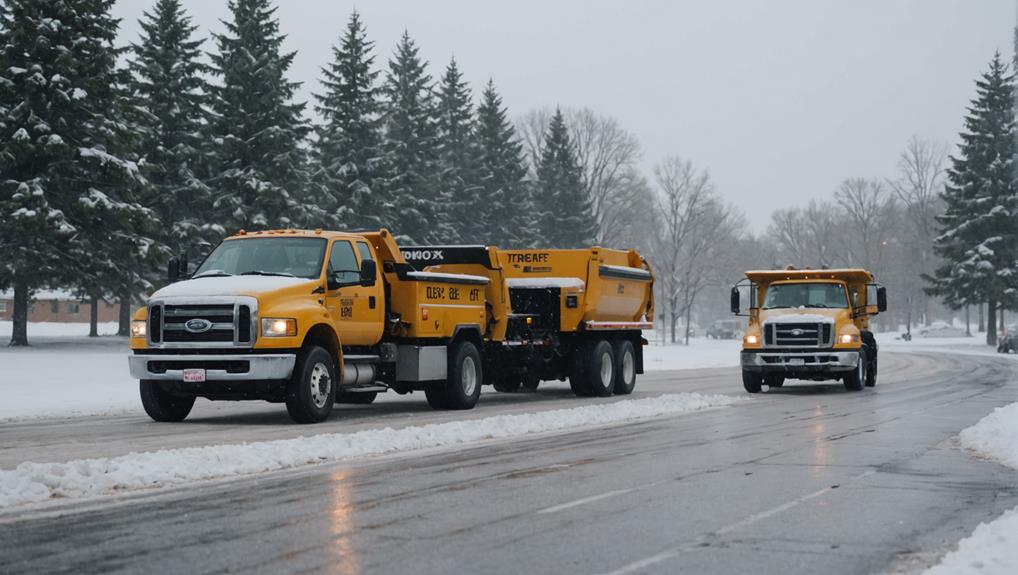
Table Of Contents
Safety Practices in Snow Hauling
Snow hauling involves certain inherent risks, making safety practices essential for protecting both personnel and the public. Operators must utilize proper equipment designed to handle winter conditions, including plows and trucks equipped with chains and good traction tires. Regular inspections of vehicles should be a priority to ensure that all components are functioning correctly and can withstand the demands of snow removal. Training sessions for personnel are crucial to impart knowledge about safe operating procedures and emergency protocols.
Additionally, clear communication is vital during snow hauling operations. This includes notifying the public of scheduled snow removal activities and any road closures. Flaggers or signs should be employed to direct traffic safely around work zones. Storing de-icing materials in designated locations minimizes the risk of spills and contamination. Implementing these safety practices not only protects workers but also helps maintain the safety of the community during winter weather events.
Ensuring Personnel and Public Safety
Ensuring personnel and public safety during snow hauling operations is paramount, given the hazards associated with winter conditions. Snow hauling often involves navigating slippery roads and working in low visibility, which can pose significant risks not only to operators but also to pedestrians and other vehicles. Training for operators is essential, focusing on safe driving techniques and equipment handling. Proper signage and barriers should be strategically placed to alert the public and secure work zones, minimizing the likelihood of accidents.
In addition to operator training, personal protective equipment (PPE) plays a critical role in maintaining safety during snow hauling activities. Workers should wear appropriate attire that provides warmth, visibility, and protection from falling snow and debris. Regular safety meetings can help reinforce best practices while encouraging open communication about potential hazards. By prioritizing both equipment safety and worker well-being, snow hauling services can effectively mitigate risks associated with winter weather operations.
Environmental Impact of Snow Hauling
Snow hauling can significantly affect local ecosystems, especially when large quantities of snow are transported from urban areas. The practice often removes snow that contains pollutants accumulated from roads, including oils, heavy metals, and other harmful substances. As this contaminated snow is transported to dumping sites, there is potential for those pollutants to leach into surrounding soil and waterways, presenting a risk to flora and fauna. Furthermore, the act of snow hauling can disrupt habitats, particularly in sensitive areas where wildlife relies on undisturbed ground cover during winter months.
Mitigating the environmental impact of snow hauling involves careful planning and execution of routes. Operators can select dumping sites that are less likely to disrupt local ecosystems while ensuring that containment measures are in place to minimize pollution runoff. Communities are also encouraged to adopt more sustainable practices, such as using snow-melting technologies or recycling snow back into local water systems. By addressing these ecological concerns, the negative implications of snow hauling can be reduced, allowing for more harmonious coexistence between urban management and nature.
Addressing Ecological Concerns
Snow hauling can have significant ecological effects, particularly when it comes to the management of snow disposal sites. These locations can disrupt local ecosystems if not managed properly. When snow is removed from urban areas, it often contains contaminants, such as salt, chemicals, and debris, which can harm the surrounding environment when dumped into natural landscapes or water bodies. Careful consideration of disposal methods is essential to mitigate potential damage.
Additionally, the machinery used in snow hauling can contribute to air and noise pollution. Heavy equipment generates emissions that may affect air quality, particularly in densely populated regions. Addressing these concerns requires the implementation of eco-friendly practices, such as using equipment that meets environmental standards. Developing strategies for recycling and managing the contaminants within snow ensures that snow hauling services do not compromise the health of local ecosystems.
Cost Factors in Snow Hauling Services
Cost factors in snow hauling services can vary significantly based on several variables. The type of equipment used plays a crucial role in determining the overall cost. Larger vehicles like snowplows and dump trucks typically require higher operational expenses, including fuel consumption and maintenance. Additionally, the geographical area can influence pricing, with urban environments often incurring higher fees due to the complexity of managing snow in densely populated locations.
Labor costs also contribute to the total expenses associated with snow hauling. Professionals skilled in snow removal may command higher wages, particularly in regions that experience severe winter weather. Companies must also factor in insurance, permits, and potential overtime for employees when calculating the overall budget. These financial considerations are critical for businesses and municipalities seeking reliable snow hauling services.
Budgeting for Operations
Proper budgeting is essential for any snow hauling operation. Businesses must account for various costs such as equipment maintenance, fuel, and labor. Additionally, unexpected weather conditions can significantly alter operational expenses. Being prepared for fluctuations in snow volume helps organizations allocate resources effectively and manage their financial health throughout the season.
Investing in technology can also enhance the efficiency of snow hauling operations. GPS systems streamline route planning, reducing fuel consumption and time on the job. While initial investments in such technology may seem high, the long-term cost savings and improved service quality typically justify the expenditure. Effective budgeting ensures that snow hauling operations remain sustainable while meeting the demands of clients and the community.
FAQS
What is snow hauling?
Snow hauling refers to the process of removing snow from an area and transporting it to a designated location. This is typically done to clear roads, parking lots, and other spaces to ensure safety and accessibility during winter weather.
Why is safety important in snow hauling?
Safety is crucial in snow hauling to protect both personnel and the public. Ensuring that workers are trained and equipped with proper safety gear helps prevent accidents, while careful operation of equipment minimizes risks to pedestrians and drivers.
What are some environmental concerns related to snow hauling?
Snow hauling can impact the environment in various ways, such as the disruption of local ecosystems, potential contamination of water sources, and the effects of transporting snow to different areas. Addressing these concerns involves implementing sustainable practices during the hauling process.
How do cost factors influence snow hauling services?
Cost factors in snow hauling services can vary based on several elements, including equipment maintenance, labor wages, fuel costs, and the scale of the operation. Budgeting effectively is essential for organizations to manage these costs while providing efficient snow removal services.
Who typically provides snow hauling services?
Snow hauling services are often provided by specialized contractors, municipal agencies, or landscaping companies equipped with the necessary machinery and expertise to handle snow removal and transportation effectively.




